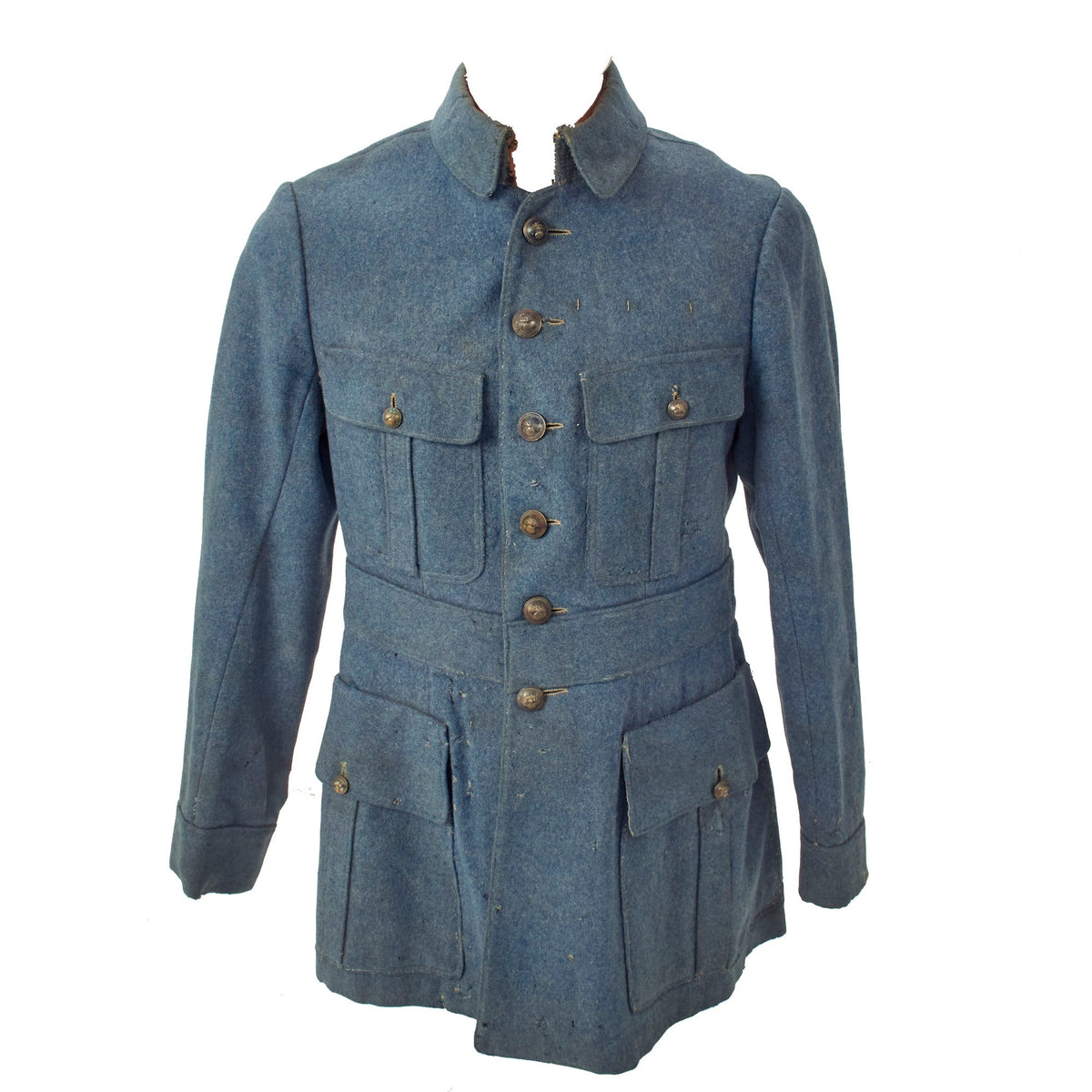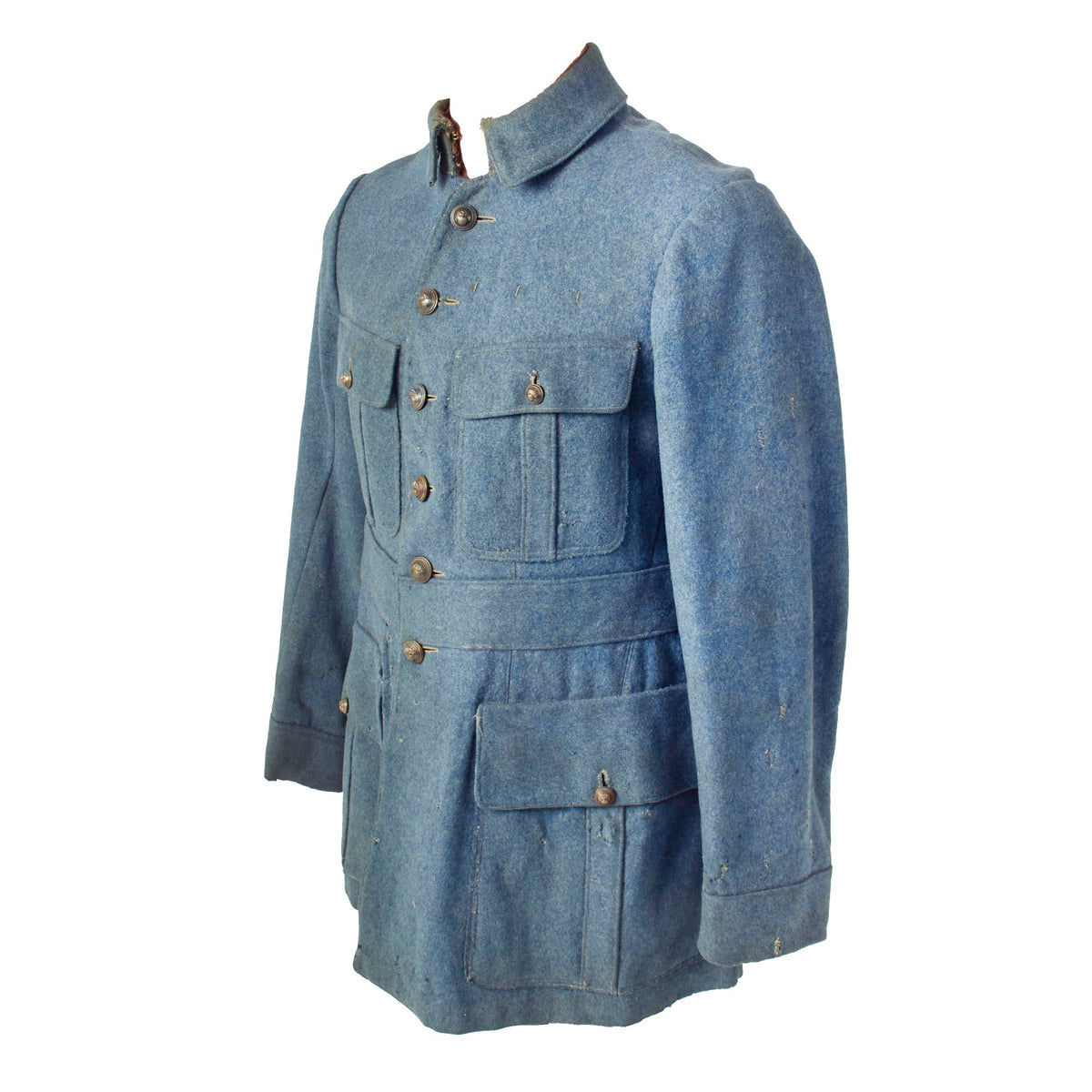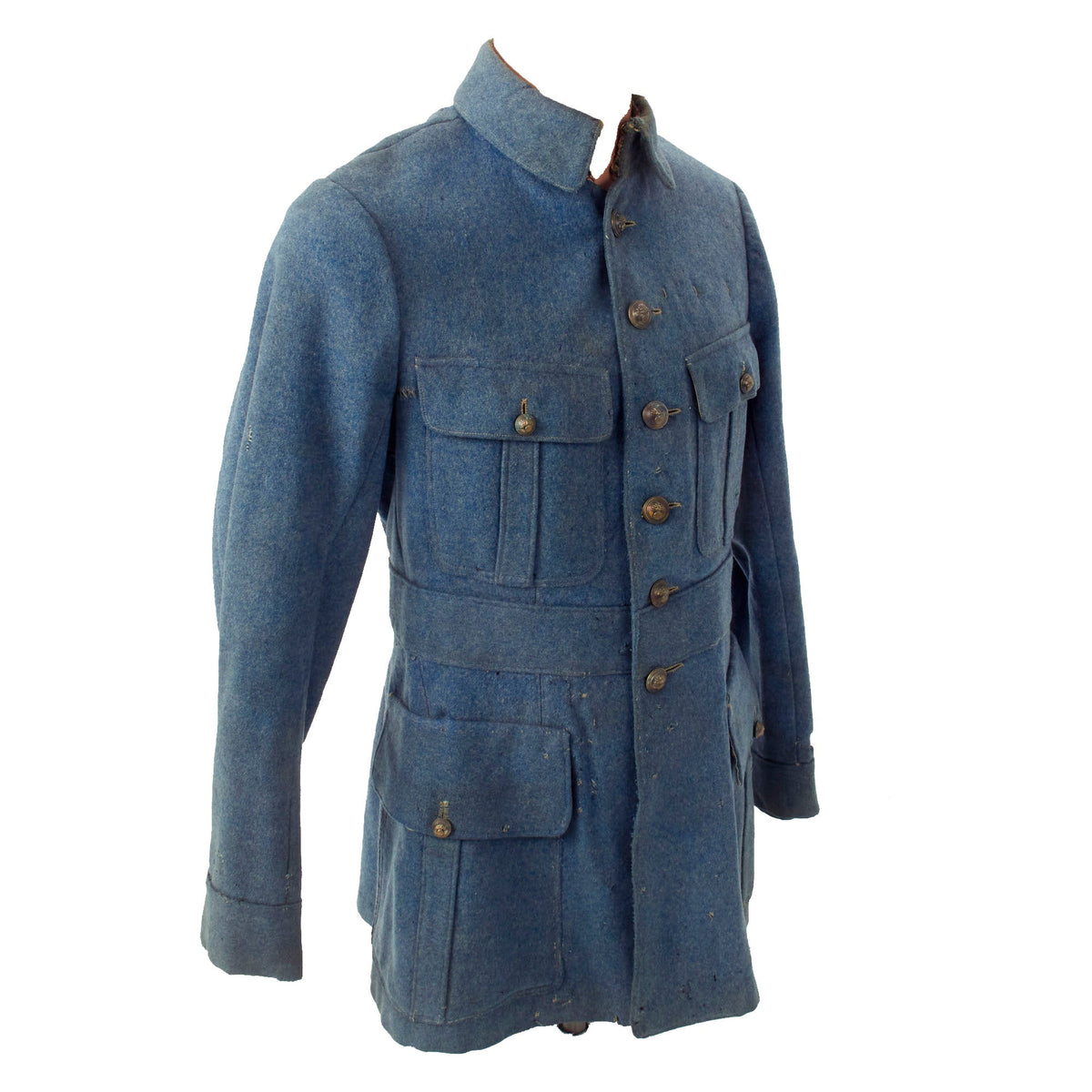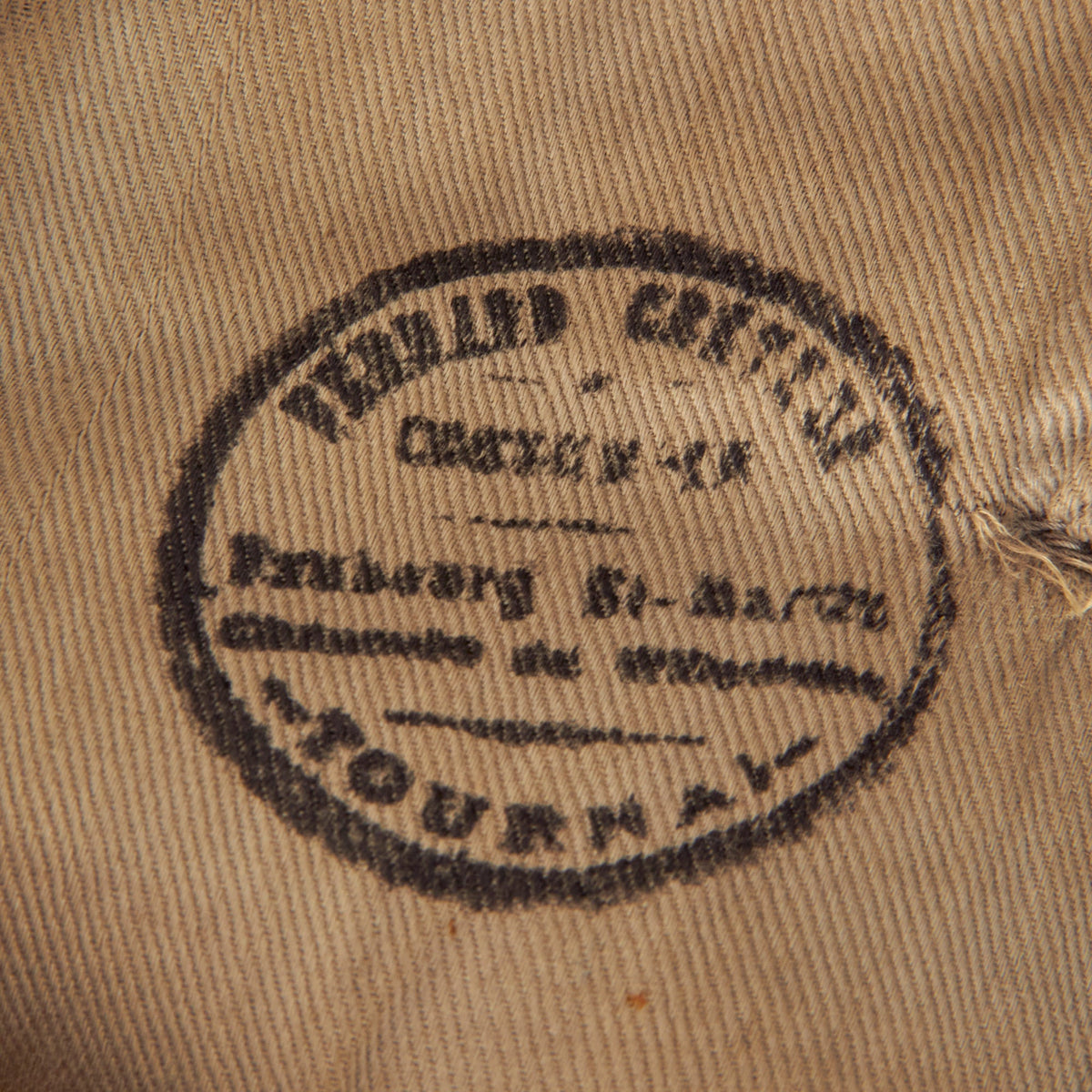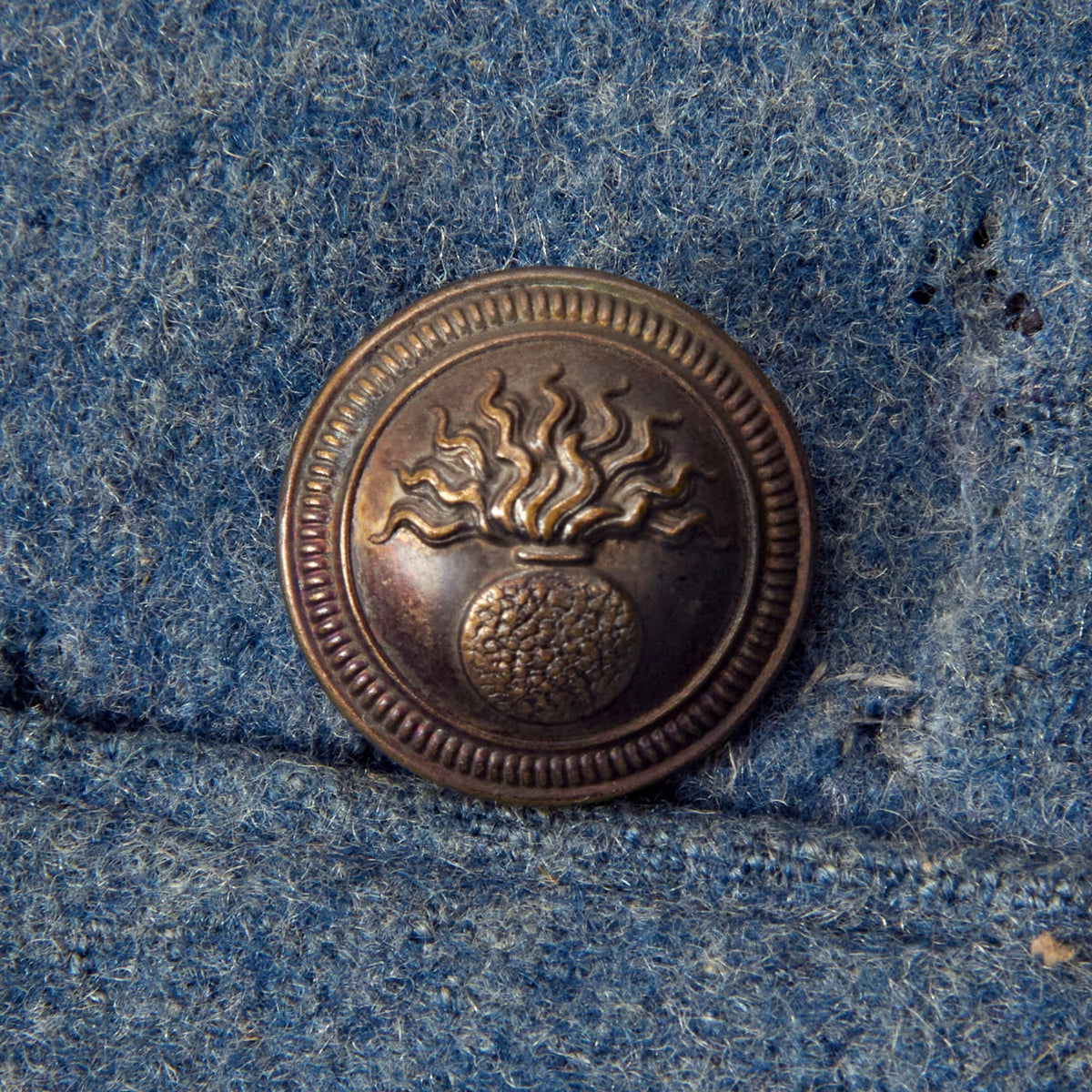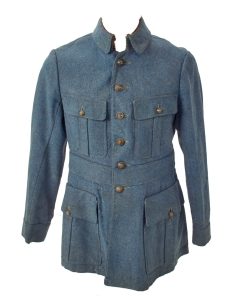Original French WWI Horizon Blue Uniform Top Original Items
$ 595,00 $ 178,50
Original Item: Only One Available. This heavy wool tunic is in lovely, field used condition with various field repairs done to it as well as what appears to be possible post war repairs. The buttons still retain their original finish and all appear to be present. The tunic appears as “rough” but you have to keep in mind that the French, as well as the rest of the world, had fought a long and brutish war in their backyards. Resupplies were cut off, ambushed and attacks were always present and they were unable to acquire new items so the soldiers would have to repair and reuse what they already had, and this is a great example of that.
At the outbreak of war the French Army retained the colorful traditional uniforms of the nineteenth century for active service wear. These included conspicuous features such as blue coats and red trousers for the infantry and cavalry. The French cuirassiers wore plumed helmets and breastplates almost unchanged from the Napoleonic period. From 1903 on several attempts had been made to introduce a more practical field dress but these had been opposed by conservative opinion both within the army and amongst the public at large. In particular, the red trousers worn by the infantry became a political debating point. Adolphe Messimy who was briefly Minister of War in 1911-1912 stated that “This stupid blind attachment to the most visible of colours will have cruel consequences”; however, in the following year, one of his successors, Eugène Étienne, declared “Abolish red trousers? Never!”
In order to appease traditionalists, a new cloth was devised woven from red, white and blue threads, known as “Tricolor cloth”, resulting in a drab purple-brown color. Unfortunately the red thread could only be produced with a dye made in Germany, so only the blue and white threads were used. The adoption of the blue-gray uniform known as “horizon-blue” because it was thought to prevent soldiers from standing out against the skyline, had been approved by the French Chamber of Deputies on 10 July 1914 but was not issued until later on.
Horizon blue is a color name which is well remembered because it was used for the blue-gray uniforms of French metropolitan troops from 1915 through 1921.
This name for a shade of blue which refers to the indefinable color which separates the sky from the earth, had been previously used in the world of fashion, and has been since then. It had also served as an emblem of political groups prevailing upon the army of the Great War.
Comes more than ready for display.
Approximate Measurements:
Collar to shoulder: 9.5″
Shoulder to sleeve: 25”
Shoulder to shoulder: 15”
Chest width: 17.5″
Waist width: 17.5″
Hip width: 22”
Front length: 32″
French Army in World War I
During World War I, France was one of the Triple Entente powers allied against the Central Powers. Although fighting occurred worldwide, the bulk of the conflict in Europe occurred in Belgium, Luxembourg, France and Alsace-Lorraine along what came to be known as the Western Front, which consisted mainly of trench warfare. Specific operational, tactical, and strategic decisions by the high command on both sides of the conflict led to shifts in organizational capacity, as the French Army tried to respond to day-to-day fighting and long-term strategic and operational agendas. In particular, many problems caused the French high command to re-evaluate standard procedures, revise its command structures, re-equip the army, and to develop different tactical approaches.
France had been the major power in Europe for most of the Early Modern Era: Louis XIV, in the seventeenth century, and Napoleon I in the nineteenth, had extended French power over most of Europe through skillful diplomacy and military prowess. The Treaty of Vienna in 1815 confirmed France as a European power broker. By the early 1850s, Prussian Chancellor Otto von Bismarck started a system of alliances designed to assert Prussian dominance over Central Europe. Bismarck’s diplomatic maneuvering, and France’s maladroit response to such crises as the Ems Dispatch and the Hohenzollern Candidature led to the French declaration of war in 1870. France’s subsequent defeat in the Franco-Prussian War, including the loss of its army and the capture of its emperor at Sedan, the loss of territory, including Alsace-Lorraine, and the payment of heavy indemnities, left the French seething and placed the reacquisition of lost territory as a primary goal at the end of the 19th century; the defeat also ended French preeminence in Europe. Following German Unification, Bismarck attempted to isolate France diplomatically by befriending Austria-Hungary, Russia, Britain, and Italy.
After 1870, the European powers began gaining settlements in Africa, with colonialism on that continent hitting its peak between 1895 and 1905. However, colonial disputes were only a minor cause of World War I, as most had been settled by 1914. Economic rivalry was not only a source for some of the colonial conflicts but also a minor cause for the start of World War I. For France, the rivalry was mostly with the rapidly industrializing Germany, which had seized the coal-rich region of Alsace-Lorraine in 1870, and later struggled with France over mineral-rich Morocco.
Another cause of World War I was growing militarism which led to an arms race between the powers. As a result of the arms race, all European powers were ready for war and had time tables that would send millions of reserves into combat in a matter of days.
France was bound by treaty to defend Russia. Austria-Hungary had declared war on Serbia due to the Black Hand’s assassination of Archduke Ferdinand, which acted as the immediate cause of the war. France was brought into the war by a German declaration of war on August 3, 1914.
Fast Shipping with Professional Packaging
Thanks to our longstanding association with UPS FedEx DHL, and other major international carriers, we are able to provide a range of shipping options. Our warehouse staff is expertly trained and will wrap your products according to our exact and precise specifications. Prior to shipping, your goods will be thoroughly examined and securely secured. We ship to thousands clients each day across multiple countries. This shows how we're dedicated to be the largest retailer on the internet. Warehouses and distribution centres can be located throughout Europe as well as the USA.
Note: Orders with more than one item will be assigned a processing date depending on the item.
Before shipping before shipping, we'll conduct a thorough inspection of the items you have ordered. Today, the majority of orders will be delivered within 48 hours. The delivery time will be between 3-7 days.
Returns
The stock is dynamic and we cannot completely manage it because multiple stakeholders are involved, including our factory and warehouse. So the actual stock may alter at any time. It's possible that you may not receive your order once the order has been made.
Our policy is valid for a period of 30 days. If you don't receive the product within 30 days, we are not able to issue a refund or an exchange.
You can only return an item if it is unused and in the same state as the day you received it. You must have the item in its original packaging.
Related products
Uncategorized
Armored Burgonet Helmet & Polearm from Scottish Castle Leith Hall Circa 1700 Original Items
Uncategorized
Uncategorized
Uncategorized
Uncategorized
Uncategorized
Uncategorized
Uncategorized
Uncategorized
Uncategorized
Uncategorized
Band of Brothers ORIGINAL GERMAN WWII Le. F.H. 18 10.5cm ARTILLERY PIECE Original Items
Uncategorized
Uncategorized
Angolan Rebel 1970s era 60mm Inert Display Mortar from Angolan Civil War Original Items
Uncategorized
Uncategorized
Australian WWII Owen MK1 Machine Carbine SMG Custom Fabricated Replica with Sling Original Items
Uncategorized
Uncategorized
Uncategorized
Uncategorized
Uncategorized
